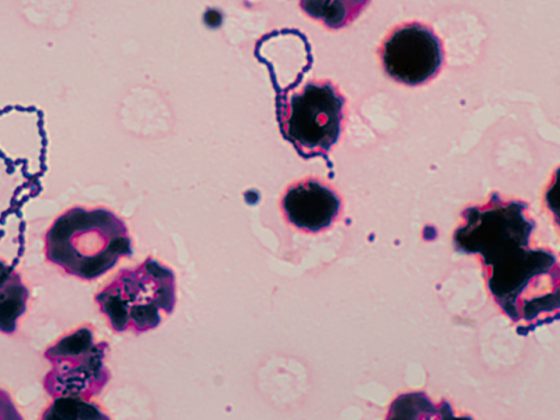At the ECTRIMS/ACTRIMS Congress, for once the pediatric population came into focus. Fingolimod was shown to be effective here as well. But the benefits don’t come “free.”
First, on ozanimod, a modulator of sphingosine-1-phosphate receptor subtype 1 and 5 (S1PR1, S1PR5). The substance is considered the “successor” or belongs to the next generation of the drug class to which fingolimod also belongs. Compared with the already approved representative, there is potential for improvement in the area of side effects. These include, for example, slowed heart rates at the start of treatment or infections and liver function abnormalities.
Data from SUNBEAM and RADIANCE were presented. The first phase III trial compared two doses of the oral agent with weekly intramuscular interferon beta-1a in 1346 patients with relapsing-remitting multiple sclerosis. The duration of therapy was at least twelve months.
Compared with interferon, significant reductions were found in several endpoints relevant to clinic and imaging:
- After an average of 13.6 months, the annualized relapse rate (ARR) was 0.18 (1 mg/d ozanimod) and 0.24 (0.5 mg/d ozanimod) compared with 0.35 (IFN). This was the primary endpoint of the study.
- Gadolinium-enhancing MRI lesions were found significantly less frequently after one year under ozanimod (reduction in the above order of 63% and 34%).
- Also, the number of new or enlarging T2 lesions over one year was reduced with ozanimod (by 48% and 25%, respectively).
- Finally, significant differences in brain volume were observed: Compared to IFN, the volume loss of the whole brain was reduced by 33% resp. 12% after one year. Median percent annual decline was -0.39 (p<0.0001) in the higher ozanimod dose and -0.5 (p=0.06) vs. -0.57 in the lower dose. Brain volume loss is considered an indicator of disease progression/activity.
Nasopharyngitis, headache, and upper respiratory tract infections occurred most frequently with ozanimod. Rates of serious adverse events were comparable in the three groups (2.9% and 3.5% vs. 2.5%), and the same was true for infection rates (including serious infections). There were no severe opportunistic infections in the ozanimod groups and no AV blocks ≥2 grade. ALT elevations were small, transient, and generally rarely necessitated treatment discontinuation. Overall, 2.9% and 1.5% vs. 3.6% of those treated discontinued their respective treatments due to adverse events. No surprises or negative signals were found compared with previous studies.
According to SUNBEAM study author Prof. Giancarlo Comi, MD, San Raffaele, the results pave the way for possible future use of the compound in relapsing-remitting MS. There is still a need for more oral therapy options with a favorable benefit-risk profile in this patient group, he said.
RADIANCE
The authors of the RADIANCE study (Part B, Phase III), in which ozanimod was studied at the same doses and with the same comparator for two years in 1320 RMS patients, take a similar view. The primary endpoint was again the annual relapse rate over the entire treatment period. It reduced significantly (again, in the order above, 0.17 and 0.22 vs. 0.28).
The same was true for imaging: Significant reductions of 42% and 34% were found with respect to new or enlarging T2 lesions and of 53% and 47% with respect to gadolinium-enhancing MRI lesions. And there was also a benefit in brain volume loss over the two years with ozanimod (-0.69 and -0.71 vs. -0.94, respectively, both p<0.0001).
Not only the efficacy but also the safety profile was consistent with that from SUNBEAM and previous studies. Thus, no AV blocks ≥2 degrees occurred. Cardiac safety, an issue to be considered with fingolimod, was judged to be good overall with ozanimod. There were no clinically relevant first-dose bradycardias. Serious cardiac events were found in 0% (1 mg) and 0.7% (0.5 mg) vs. 0.5% (IFN). 3% and 3.2% vs. 4.1% discontinued therapy due to adverse events have.
The developer plans to submit the active ingredient for approval in the USA before the end of 2017. For Europe, this is likely to be in the first half of 2018 at the earliest. Whether Swissmedic will then support the approval remains to be seen for the time being.
No significance with regard to disability progression
In a pooled analysis of SUNBEAM and RADIANCE B, ozanimod missed significance compared with IFN in the endpoint “time to confirmed disability progression over three months,” with low rates of progression in all groups. In SUNBEAM, they were 2.9% and 3.8% vs. 4.2% at the end of the study, and in RADIANCE (Part B), they were 12.5% and 9.3% vs. 11.3%.
Overall, confirmed progression rates over three months in the pooled analysis were 7.6%, 6.5% vs. 7.8% at study end.
CONCERTO – Failed in the primary endpoint
Laquinimod has had a somewhat more eventful history. The compound – an AhR activator – and its predecessor, Linomid, have been repeatedly studied in MS, sometimes with success, but the compound and its derivatives have also raised profound safety concerns. Discussions have included adverse effects on the heart and blood vessels, as well as increased cancer rates and teratogenicity in animal studies. While development of linomide was halted, laquinimod continued to be studied. Overall, its benefit-risk profile was last assessed as negative by the EMA in 2014, especially since the exact mechanism of action was unclear and longer-term harm to humans could not be ruled out. The active ingredient never received regulatory approval.
CONCERTO, the large phase III trial, was designed to shed light on questions of safety and efficacy. Initially, two oral doses (0.6 mg/d or 1.2 mg/d) were still tested, but the arm with the higher dose was then closed in January 2016. Now it turned out that laquinimod missed the primary endpoint even at the lower dose. This was defined as “time to confirmed disability progression over three months.” There was no benefit in participants with relapsing-remitting MS (RRMS) compared to placebo (hazard ratio of 0.937; p=0.7057).
Thus, it did not benefit the initiators to have chosen this endpoint in CONCERTO instead of the annual relapse rate as in the previous phase III trials called ALLEGRO and BRAVO. At that time, the effects on disability progression had been far more promising than those on relapse rate. Now that disability has “ascended” to the primary endpoint, the differences disappear (causing long faces even among the study authors) – whereas they remained relevant in the thrust rate. Indeed, the latter also significantly reduced by 25% in CONCERTO, as did the number of gadolinium-enhancing T1 lesions at 15 months (exploratory end points). Significantly positive were also the secondary endpoints of brain volume loss (40 percent improvement over placebo at month 15) and time to first relapse (28 percent risk reduction), whereas confirmed disability progression at six and nine months was again not significantly different from placebo.
So although there are positives to report, the further development of the compound in RRMS is now more than questionable. Studies evaluating laquinimod in other indications such as primary progressive MS or Huntington’s disease are ongoing. We will see whether the active ingredient is more convincing there.
The safety profile of 0.6 mg/d laquinimod was within the tolerable range in CONCERTO: Headache, nasopharyngitis, back pain, and arthralgia were common. Overall, the authors did not see any major difficulties or concerns with the use of the drug. However, safety considerations, mainly of a cardiovascular nature, were the reason for the early closure of the higher-dose arm in 2016. It therefore remains to be seen which winding paths the development of the active ingredient will follow.
Fingolimod is also convincing in children
Clinical trials with pediatric populations are generally rare. Therefore, the randomized-controlled PARADIGMS trial, which evaluated fingolimod in RRMS patients aged ten to 17 years, is a notable exception. It is the first ever phase III trial to evaluate disease-modifying MS therapy in pediatric patients. Accordingly, the results met with broad interest at the ECTRIMS/ACTRIMS congress. Because although they may be rare, they do exist, the patients who develop MS before the age of 18. It is thought to affect 3-5% of all people with MS. In this case, the thrust rate is significantly increased, namely by two to three times compared to the adult population. There is an earlier risk of disability than in adult MS patients.
Can fingolimod, which had shown a remarkable reduction in annual relapse rate in the FREEDOMS trials (but just in adults), help here? And at what cost is this benefit achieved, i.e., what side effects can be expected in the pediatric population? Exciting and highly relevant questions; after all, no evidence-based therapy currently exists for the pediatric population. There is simply a lack of randomized controlled clinical trials that would establish a clear indication. With PARADIGMS, this is now set to change.
It compared body weight-adapted fingolimod (0.25-0.5 mg) with intramuscular interferon beta-1a (30 µg/week), for which limited published data suggest that the safety profile in adolescents aged 12 to 18 years is the same as that in adults, according to the SmPC. The 215 patients had experienced at least one relapse in the past year or two relapses in the past two years or showed gadolinium-enhancing MRI lesions within the last six months before randomization. The blinded phase of the study lasts up to two years, and the open-label phase lasts another five years.
The primary endpoint showed an 82 percent relative risk reduction in annual relapse rate (collected over up to two years of treatment): 0.67 vs. 0.12, (p<0.001). Time to first relapse was prolonged; 39% on IFN and 86% on fingolimod were relapse-free after two years. Imaging also showed significant reductions in new or enlarging T2 lesions and gadolinium-enhancing lesions. Brain volume loss was lower after two years: -0.80 vs. -0.48 (p=0.014). Lastly, a significant effect could be observed in the time to confirmed disability progression over three months.
In summary, it is a success all along the line. This is to be expected with the approval extension. But what about the side effects? There were more serious adverse events with fingolimod than with IFN (at 18%, there were about twice as many). These included epileptic seizures (4 cases), leukopenia (2 cases), agranulocytosis (1 case), and 2nd-degree AV block (1 case). However, regular adverse events were more frequent under IFN.
Overall, according to the study authors, the safety profile proved to be consistent with that from studies with adults – a very important statement that makes the use of the active ingredient also appear reasonable in children and adolescents.
Source: 7th ECTRIMS-ACTRIMS 2017, October 25-28, 2017, Paris (F).











